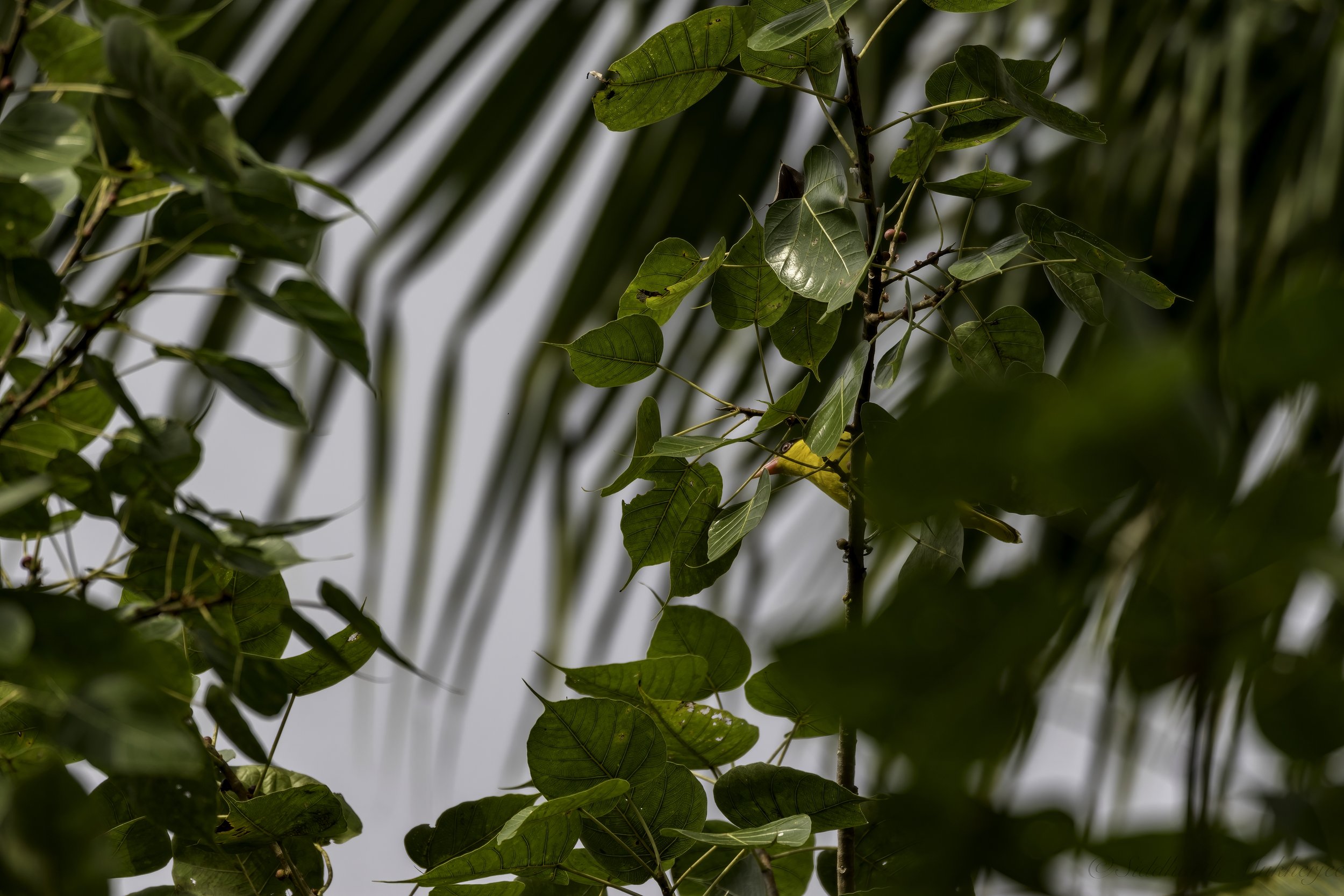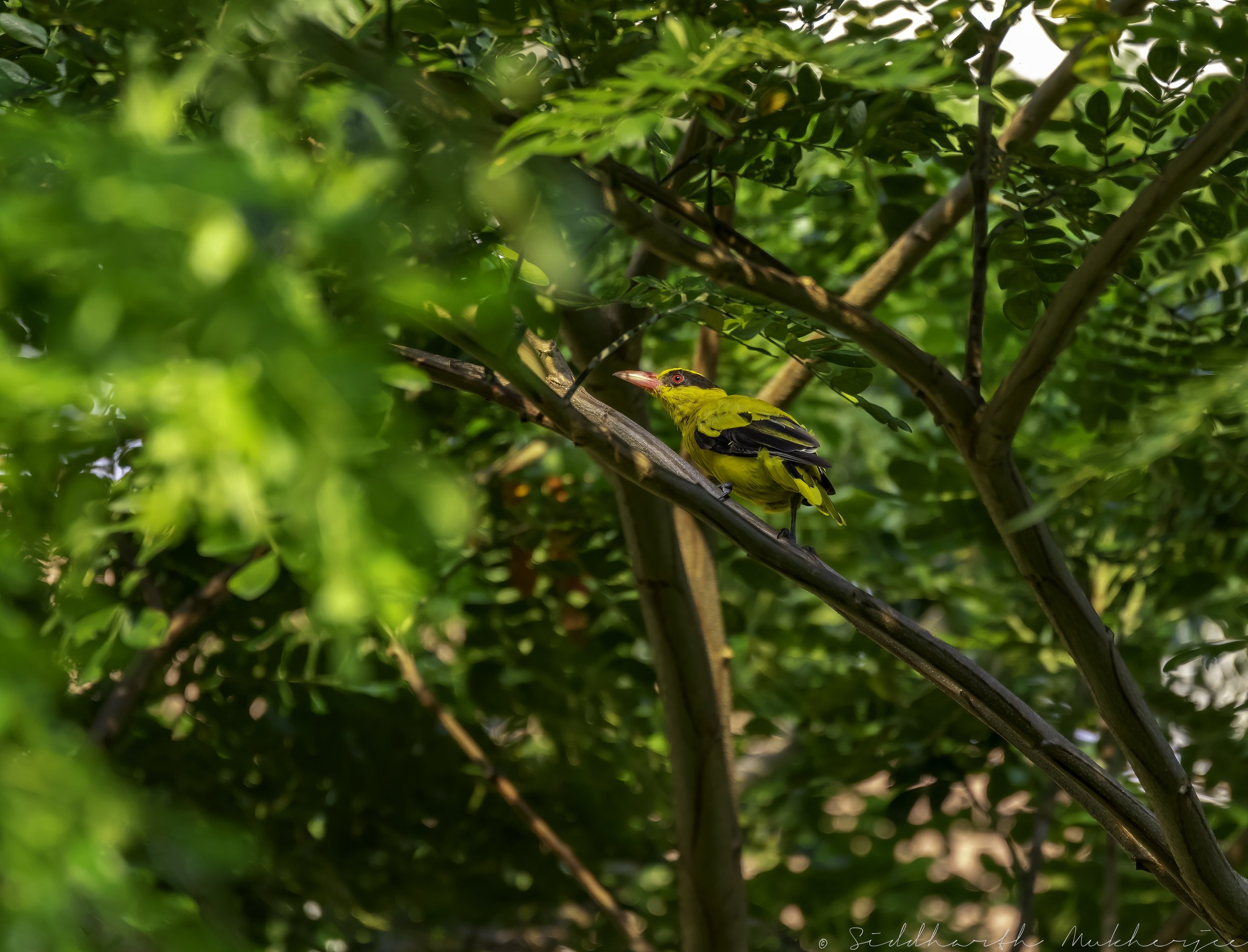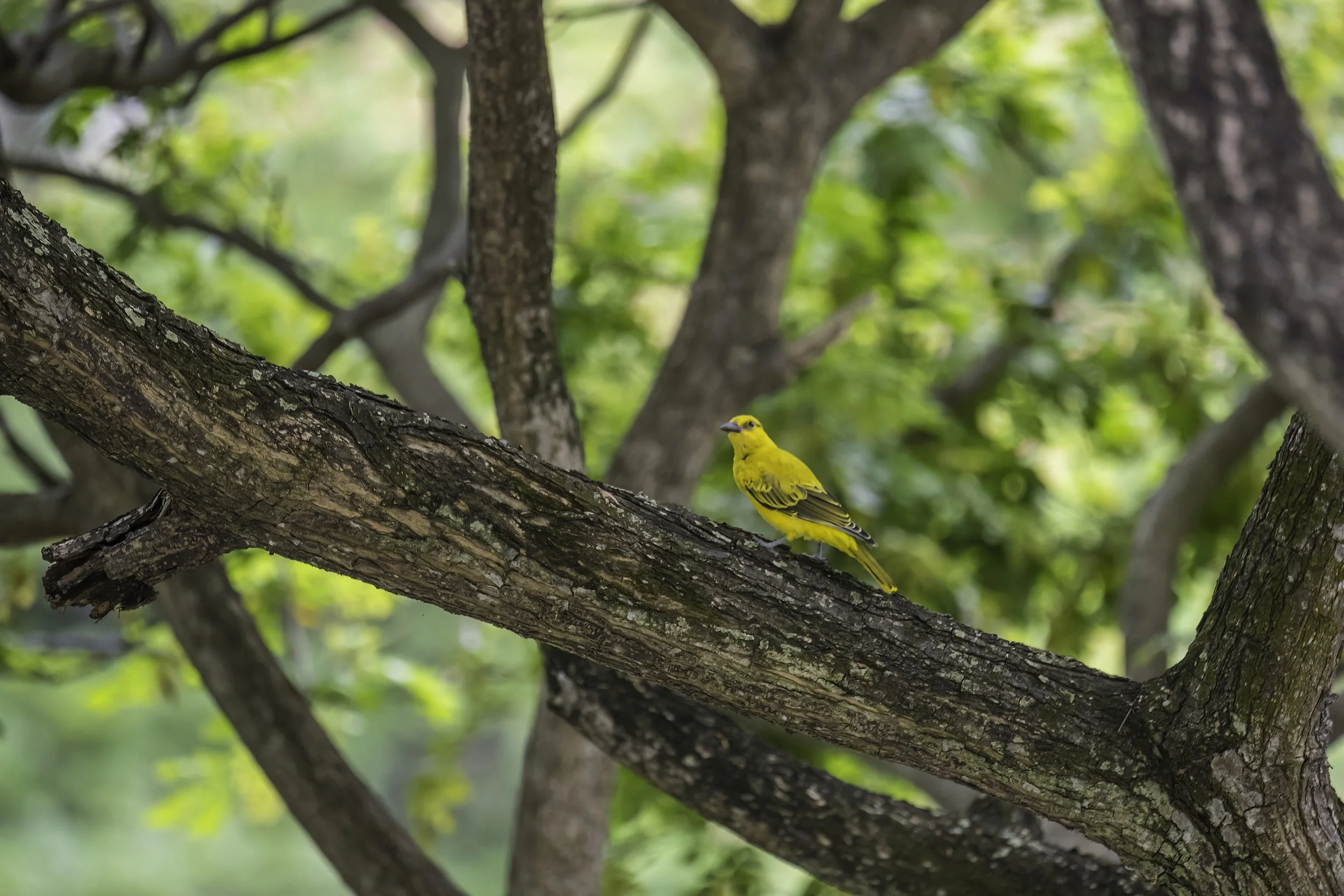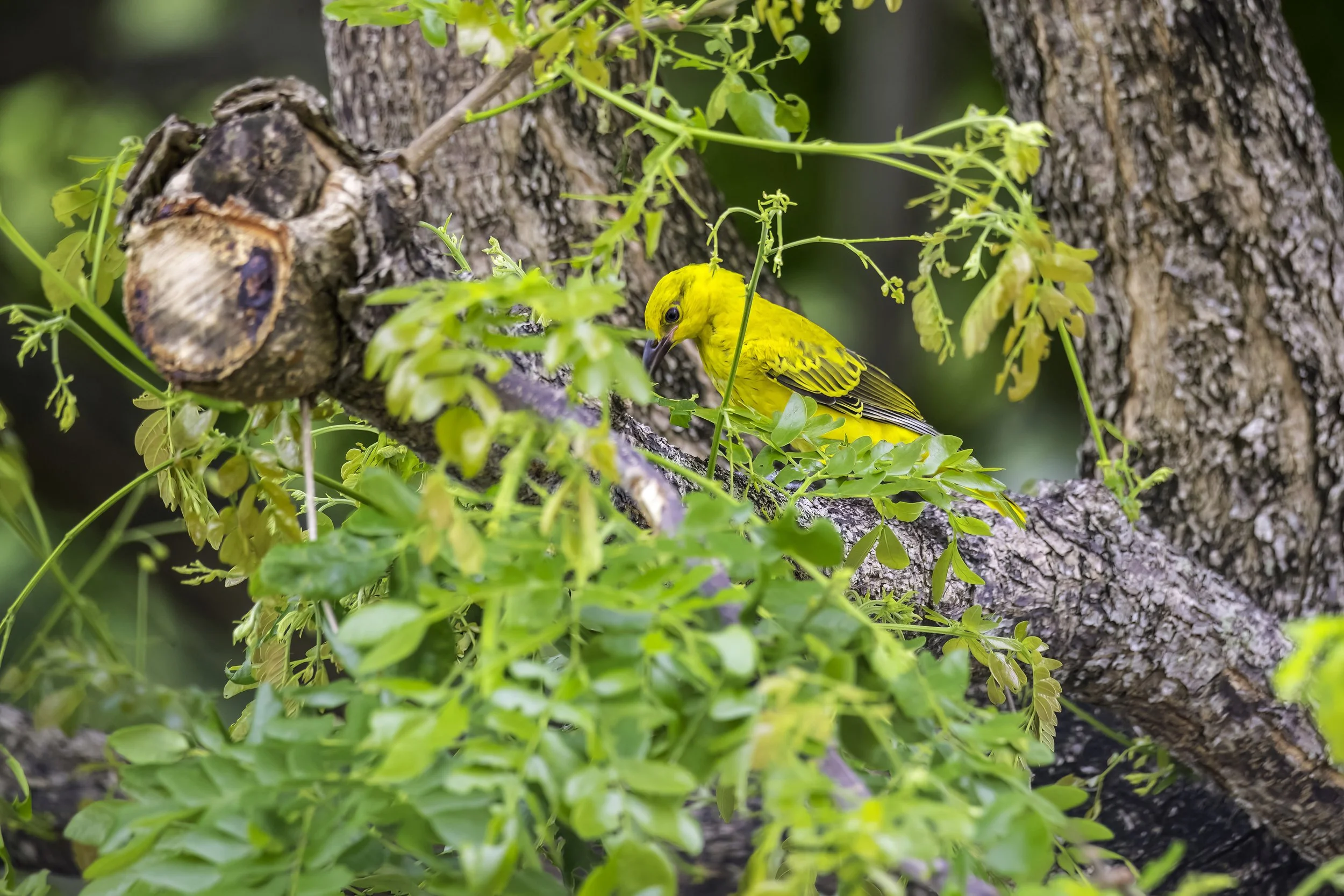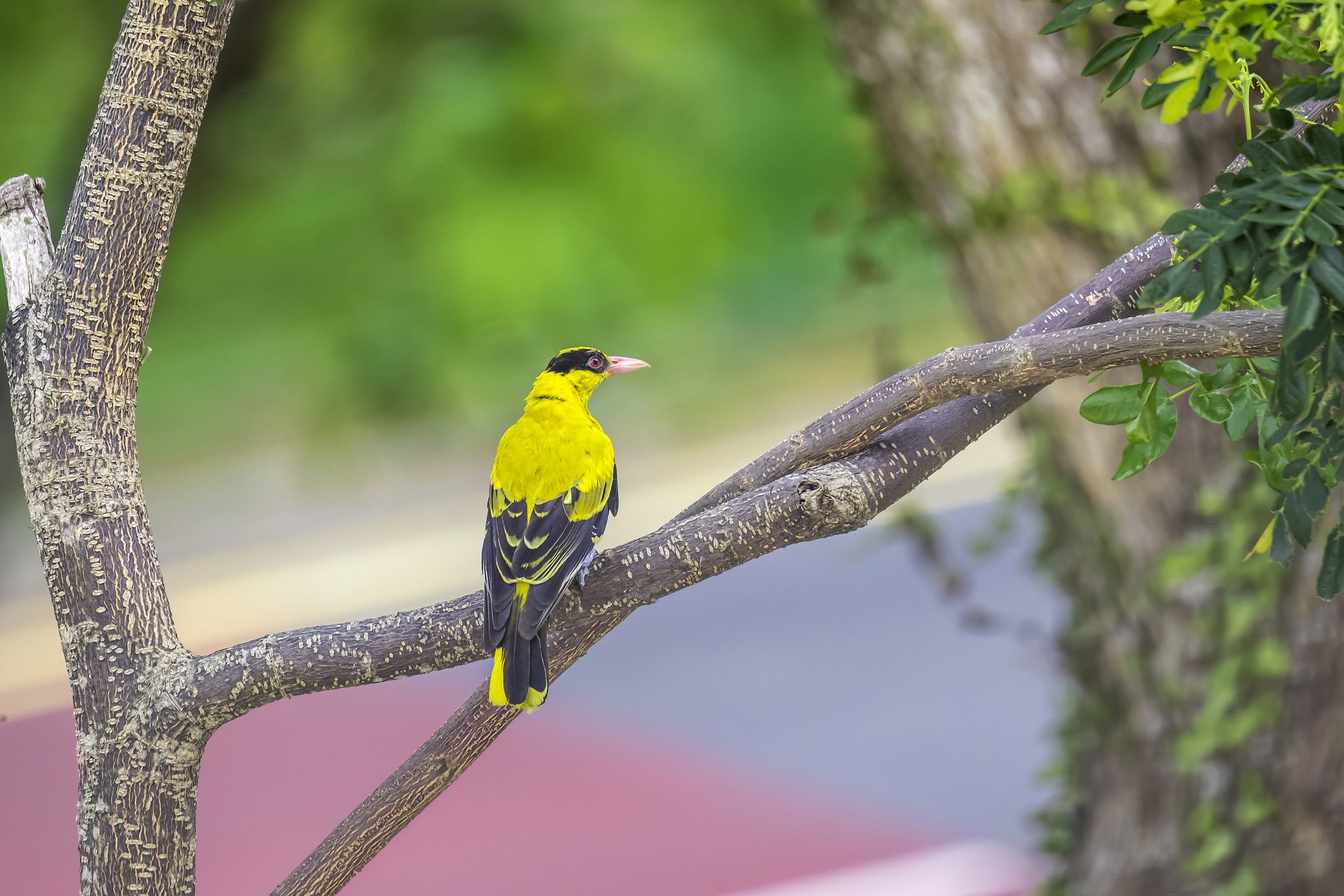Black-naped Oriole
Oriolus chinensis
South & West Indian Subcontinent & Southeast Asia
The Old World orioles (Oriolidae) are an Old World family of passerine birds. The family contains 41 species which are divided in 4 genera. The family includes two extinct species from New Zealand that are placed in the genus Turnagra. The family Oriolidae comprises the piopios, figbirds, pitohuis and the Old World orioles. The piopios were added 2011, having been formerly placed in the family Turnagridae. Several other genera have been proposed to split up the genus Oriolus. For example, the African black-headed species are sometimes placed in a separate genus, Baruffius. The family Oriolidae is not related to the New World orioles, despite their similar size, diet, behaviour and contrasting plumage patterns. Rather, these similarities are an example of convergent evolution. There are at least two extinct genera in the family Oriolidae:
Genus Turnagra – piopios (2 extinct species)
Genus Longmornis – Longmornis robustirostrata
The orioles and figbirds are medium-sized passerines, around 20–30 cm in length, with the females only slightly smaller than the males. The beak is slightly curved and hooked, and, except in the figbirds, as long again as the head. The plumage of most species is bright and showy, although the females often have duller plumage than the males do. The plumage of many Australasian orioles mimics that of friarbirds (a genus of large honeyeaters), probably to reduce aggression against the smaller orioles. The family is distributed across Europe, Africa, Asia, and Australia. The few temperate nesting species are migratory, and some tropical species also show seasonal movements. Orioles are arboreal and tend to feed in the canopy. Many species are able to survive in open forests and woodlands, although a few are restricted to closed forest. They are opportunistic omnivores, with the main components of their diet being fruit, berries, arthropods, and nectar.
The Black-naped Oriole (Oriolus chinensis) is a passerine bird in the oriole family that is found in many parts of Asia. There are several distinctive populations within the wide distribution range of this species and in the past the slender-billed oriole (Oriolus tenuirostris) was included as a subspecies. Unlike the Indian Golden Oriole which only has a short and narrow eye-stripe, the black-naped oriole has the stripe broadening and joining at the back of the neck. Males and females are very similar although the wing lining of the female is more greenish. The bill is pink and is stouter than in the golden oriole.
Birding in Singapore
Singapore is a sovereign city-state and island country in Southeast Asia. It lies one degree (137 kilometres) north of the equator, at the southern tip of the Malay Peninsula, with Indonesia’s Riau Islands to the south and Peninsular Malaysia to the north. Singapore’s territory consists of one main island along with 62 other islets. Since independence, extensive land reclamation has increased its total size by 23% (130 square kilometres or 50 square miles). Its urbanisation cost it almost 95% of its historical forests and just over half of the naturally occurring fauna & flora in Singapore is present in its numerous nature reserves. These nature reserves comprise only about 0.25% of Singapore’s land area and to combat this decline the government, from 1967, has tried to make Singapore a ‘garden city’. Since then, nearly 10% of Singapore’s land has been set aside for parks & nature reserves resulting in about 350 species of birds found within an area of just 650 km² offering enthusiasts excellent birding throughout the year. The best period is between August and April when the migrants, mostly from the Palearctic fly in, and together with the resident birds make it an exciting time. There are 425 bird species that can be found in Singapore and some of the most observed birds are the Javan Myna, Yellow-vented Bulbul, Black-naped Oriole, Spotted Dove, Pink-necked Green-Pigeon, Asian Glossy Starling, Ornate Sunbird, House Crow, Collared Kingfisher & the White-breasted Waterhen.
Some of the places these birds are visible are the Bishan Ang Mo Kio Park & Sungei Buloh Wetlands just to name a couple.
Despite being an island surrounded by water, it seems there are few places where the residents of Singapore can actually interact with water with Bishan-Ang Mo Kio Park being one of them. Formerly known as Bishan Park, the 62-hectare Bishan-Ang Mo Kio Park, first opened in 1988, is located between the two housing estates of Bishan and Ang Mo Kio, in the central area of the island. It is located north of the Central Business District and just east of the Central Water Catchment, next to the Lower Pierce Reservoir. The naturalised Kallang River flows down the middle running from the Lower Pierce Reservoir to the Marina Reservoir (previously the ocean) and serves multiple purposes like flood control, water purification, aesthetic enjoyment, and recreational and educational opportunities. The park was redesigned to utilise the use of natural processes for flood and soil erosion control, with a new floodplain design and soil bioengineering. Natural processes and materials are used for water treatment and filtration with the creation of a cleansing biotope, an artificial wetland that treats and purifies the water of the river through the use of selected plants, and a network of vegetated bioswales. Biodiversity has already increased by 30%. 66 species of wildflower, 59 species of birds and 22 species of dragonfly have been identified here which isn’t bad for a city park.
The Sungei Buloh Wetlands are a wetland nature reserve in the northwest area of Singapore. It is the first wetlands reserve to be gazetted in Singapore (2002), and its global importance as a stop-over point for migratory birds was recognised by the inclusion of the reserve into the East Asian Australasian Shorebird Site Network. The reserve, with an area of 130 hectares, was listed as an ASEAN Heritage Park in 2003. It is one of those natural forests that play a big part in creating an ecological balance in the region.
The site only gained prominence in 1986 when a call was made to conserve the area by members of the Singapore Branch of the Malayan Nature Society. Particularly significant was its unusually high variety of bird species, which included migratory birds from as far as Siberia on their way to winter in Australia. Their suggestion was taken up by the government, and a site with an area of 0.87 km² was given nature park status in 1989. The Parks & Recreation Department, a precursor to today's National Parks Board, developed and managed the nature park with a team of experts. The most notable names from the team included the Wildfowl & Wetlands Trust from the United Kingdom and World Wide Fund for Nature. Sungei Buloh Wetland Reserve, then known as Sungei Buloh Nature Park, was officially opened on 6 December 1993 by then Prime Minister Goh Chok Tong.
Among the many birds that can be spotted feeding on the diverse fauna variety of worms and molluscs, are the Eurasian whimbrel, common greenshank, common redshank, Mongolian plover, curlew sandpiper, marsh sandpiper and the Pacific golden plover, the yellow and the cinnamon bitterns. There is a resident family of smooth otters as well as the rare lesser whistling-duck, and the rare milky stork. The reserve forms part of the Kranji-Mandai Important Bird Area (IBA), identified as such by BirdLife International because it supports Chinese egrets, greater spotted eagles and greater crested terns. Atlas moth, the largest species of moth in Southeast Asia can be found in the back mangrove.
Observation hides are available where visitors can observe the flora and fauna in the surroundings in tranquility and at a distance from the animals and birds. Saltwater crocodiles (Crocodylus porosus) are occasionally seen in the reserve, although it is not known whether or not these are individuals that had wandered over from Malaysia/ Indonesia or a remnant localised population. (This species was once common in Singapore but was said to be extinct.). It is one of the four nature reserves to be gazetted in Singapore.
These wetlands are my favourite place in all of Singapore.
Black-naped Oriole
The Black-naped Oriole is a typical yellow and black Old World oriole. The male is entirely golden-yellow apart from black wings & tail and a broad black band through the eyes. The tail and wings have yellow tips and the bill is deep pinkish. The female similar to the male but with more yellowish-green upperparts while the juveniles show streaked underparts. They are found in a variety of forest habitats, including plantations and gardens; forages in forest canopy.
In 1760 the French zoologist Mathurin Jacques Brisson included a description of the black-naped oriole in his Ornithologie based on a specimen that he mistakenly believed had been collected in the former French colony of Cochinchina in what is now southern Vietnam. He used the French name Le loriot de la Cochinchine and the Latin Oriolus Cochinsinensis. Although Brisson coined Latin names, these do not conform to the binomial system and are not recognised by the International Commission on Zoological Nomenclature. When in 1766 the Swedish naturalist Carl Linnaeus updated his Systema Naturae for the twelfth edition, he added 240 species that had been previously described by Brisson. One of these was the black-naped oriole. Linnaeus included a brief description, coined the current binomial name Oriolus chinensis ("Chinese oriole") and cited Brisson's work. The type location was subsequently corrected to Manila in the Philippines.
The evolutionary history of this group of orioles is complex and there may be more cryptic species within the group. The subspecies are very closely related and the group forms a clade in which the Eurasian Oriole and Indian Golden oriole are also nested.
Twenty subspecies are recognised:
Oriolus chinensis diffusus (Sharpe, 1877): Originally described as a separate species. Found in the eastern Palearctic
Oriolus chinensis andamanensis (Beavan, 1867): Originally described as a separate species. Found on the Andaman Islands
Oriolus chinensis macrourus (Blyth, 1846): Originally described as a separate species. Found on the Nicobar Islands
Oriolus chinensis maculatus (Vieillot, 1817): Originally described as a separate species. Found on the Malay Peninsula, Sumatra, Belitung, Bangka Island, Nias, Java, Bali and Borneo
Oriolus chinensis mundus (Richmond, 1903): Originally described as a separate species. Found on Simeulue and Nias Is.
Oriolus chinensis sipora (Chasen & Kloss, 1926): Found on Sipora (off western Sumatra)
Oriolus chinensis richmondi (Oberholser, 1912): Found on Siberut and Pagi Island (off western Sumatra)
Oriolus chinensis lamprochryseus (Oberholser, 1917): Found on Masalembu and Keramian Islands (Java Sea)
Oriolus chinensis insularis (Vorderman, 1893): Originally described as a separate species. Found on Sapudi, Raas and Kangean Islands (northeast of Java)
Oriolus chinensis melanisticus (Meyer, AB & Wiglesworth, 1894): Originally described as a separate species. Found on Talaud Islands (south of the Philippines)
Oriolus chinensis sangirensis (Meyer, AB & Wiglesworth, 1898): Found on the Sangihe Islands (off north-eastern Sulawesi)
Oriolus chinensis formosus (Cabanis, 1872): Originally described as a separate species. Found on Siau, Tahulandang, Ruang, Biaro and Mayu Islands (off north-eastern Sulawesi)
Oriolus chinensis celebensis (Walden, 1872): Originally described as a separate species. Found on Sulawesi and nearby islands
Oriolus chinensis frontalis (Wallace, 1863): Originally described as a separate species. Found on Banggai and Sula Islands (east of Sulawesi)
Oriolus chinensis stresemanni (Neumann, 1939): Found on Peleng (off eastern Sulawesi)
Oriolus chinensis boneratensis (Meyer, AB & Wiglesworth, 1896): Originally described as a separate species. Found on Bonerate, Djampea and Kalao Islands (Selayar Islands)
Oriolus chinensis broderipi (Bonaparte, 1850): Originally described as a separate species. Found on Lombok, Sumba, Sumbawa, Flores, and Alor Island (Lesser Sunda Islands)
Oriolus chinensis chinensis (Linnaeus, 1766): Found on Palawan, Luzon, Mindoro and satellite islands (western and northern Philippines)
Oriolus chinensis yamamurae (Kuroda Sr, 1927): Found on the Visayan Islands, Mindanao and Basilan (central and southern Philippines)
Oriolus chinensis suluensis (Sharpe, 1877): Found in the Sulu Archipelago (south-western Philippines)
The Black-naped Oriole is medium-sized and overall golden with a strong pinkish bill and a broad black mask and nape. The adult male has the central tail feathers tipped yellow and the lateral ones are more broadly yellow as you can see in the photo above. The female has the mantle colour more greenish or olive. The juvenile has a streaked underside. The nestling has dull greenish with brown streaks. The head and nape are more yellowish and the undertail coverts are yellow. Several variations exist in the populations that have been separated as subspecies.
The subspecies in the Andamans, O. c. andamanensis has all black wings while O. c. macrourus of the Nicobars has a very broad nape band so that only the top of the head is yellow. The wings are all black with a yellow primary covert patch. The calls of the Andaman and the Nicobar subspecies are said to be quite different, the latter having a more modulated call note. In the Southeast Asian populations some geographic trends include a reduction of yellow on the forehead and a decreased brightness in the yellow plumage from north to south. Females from southern populations are more greenish on the back and tail and there are no yellow spots on the tips of the secondaries as in northern populations.
The usual call is a nasal niee or myaa and the song (diffusus) is a fluty iwee wee wee-leeow. They have a dipping flight. I had the good fortune to observe these birds from the balcony of my apartment and I noticed that the black-naped oriole has a huge variety of calls - well over 50 different calls/songs. I did try to record but gave up after almost 19 different calls and/or songs. The diversity of the calls is immense with different hissing alert/warning calls which seem to apply more to the fledglings or juveniles rather than intruders. The fledglings on the other hand chirp incessantly from sunrise to sunset more or less. As these are still dependent on the parents for their sustenance, this incessant calling, I think, helps the parents to quickly locate them. There seem to be a number of territorial & courtship calls which vary in the number of ‘syllables’ uttered in an ascending order. They range from 1 to a maximum of 5 with some beginning with a softly uttered and barely audible common syllable that sounds like ‘gig’ (as in giggle).
Black-naped Oriole - Range & Distribution India
Subspecies diffusus breeds in eastern Siberia, Ussuriland, northeastern China, Korea, Japan and northern Vietnam and is widespread across India during winter, mainly in the northeastern parts and in the peninsular region and also found in Bangladesh. The population in the Andaman and Nicobar Islands are resident. In winter, populations breeding in eastern Asia spend the winter in the tropical areas of Southeast Asia such as Thailand and Myanmar. Subspecies diffusus is an uncommon migrant in many parts of South India and very rare migrant to Sri Lanka and are most regularly seen in the Western Ghats. In Singapore they are believed to have established as breeders only in the 1920s and are today common even within gardens in the city. In the 1880s they were considered rare. At the present time, orioles are fairly common in Singapore.
The black-naped oriole are distributed in Russia, China, North Korea, South Korea, Taiwan, India, Bangladesh, Myanmar, Thailand, Cambodia, Laos, Vietnam, Malaysia, Singapore, Brunei, Indonesia and Philippines. In India, wintering black-naped oriole species are distributed in the states of Gujarat, Madhya Pradesh, Maharashtra, Karnataka, Goa, Kerala, Tamil Nadu, Telangana, Andhra Pradesh, Odisha, Jharkhand, West Bengal, Assam, Meghalaya, Nagaland, Manipur and Tripura. The black-naped oriole nominate subspecies O. c. chinensis is distributed in Philippines. The subspecies O. c. diffusus is migratory and occurs in China, Russia, North Korea, South Korea and northern parts of Myanmar, Laos and Vietnam. The oriole subspecies O. c. andamanensis is endemic to the Andaman Islands. The subspecies O. c. macrourus is endemic to the Nicobar Islands. The subspecies O. c. melanisticus is distributed in the Talaud Islands of Philippines. These black-naped oriole species have moderate forest dependence. They normally occur in altitudes from 0 to 2000 meters. The artificial ecosystems and habitats of these species include urban areas, plantations and rural gardens.
The natural ecosystems and habitats of these black-naped oriole species include tropical and subtropical mangrove forests, evergreen forests, tropical and subtropical moist lowland forests, deciduous forests and moist montane forests.
Related Posts

